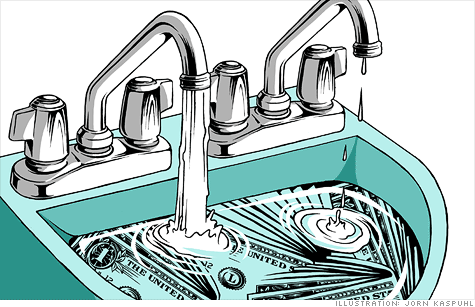Search News

When it comes to dollar-cost averaging, investing immediately for your selected asset allocation is more likely to generate a higher rate of return.
(MONEY Magazine) -- "Should I put all the money I have to invest in the market now or add it gradually over time?" -- Paul B., Louisiana
During the nearly 30 years I've been at MONEY, dollar-cost averaging -- or moving the same amount of money from cash to stocks and bonds each month over the course of a year or more -- has been largely accepted by market pros and individual savers alike as an ideal way to invest. You don't know when the market will sink or soar, the rationale goes, so you're better off tiptoeing in than taking the plunge. Dollar-cost averaging has achieved the status of investing Truth with a capital T.
The only problem is that for even longer, economists have known that this is an inefficient way to buy stocks and bonds: Going directly to your ideal asset allocation is more likely to generate a higher return for any given level of risk than moving to that mix gradually. Dollar-cost averaging, it turns out, is more of a psychological crutch than a shrewd investing strategy.
Because stocks and bonds usually outperform cash, chances are you'll earn more by getting into the market as quickly as possible. But that's not dollar-cost averaging's biggest shortcoming.
As an investor, you need to think about your goals, your time horizon, and risk. The best way to address all three factors is to settle on a stock and bond mix that has a realistic shot of delivering reasonable long-term returns with a level of volatility that you can accept -- and then rebalance periodically. Generally, the more time you have and the more comfortable you are dealing with market downturns, the more you should allocate to stocks. (To arrive at a blend, use a tool like Morningstar's Asset Allocator.)
Let's say you have $120,000 in cash and decide on a mix of 60% stocks and 40% bonds. How do you get to that allocation? You could immediately stash $72,000 into a diversified group of stocks and $48,000 into a broad range of bonds. Or you could shift $10,000 a month ($6,000 into stocks, $4,000 into bonds) over a year.
If you go that second route, think about what you're actually doing. After deciding on a 60/40 blend, you'll need more than a year to reach that goal. As the table below shows, what you're really doing during that time is going through a series of allocations that are too conservative. By dollar-cost averaging, you're undermining the asset-allocation strategy you settled on.
Ah, but what if stock and bond prices fall during those 12 months? Wouldn't you come out ahead if you had averaged in? Yes, you probably would. The opposite is true, however, if stocks and bonds had done well throughout the year. The point is you never know what the markets will do. That uncertainty is why you set an asset allocation in the first place.
Here's another way to think about it: If dollar-cost averaging is so great, why stop doing it once you're fully invested? The threat of sudden downturns will still be there. So why not liquidate your portfolio and dollar-cost-average back into stocks and bonds all over again? And then do it again and again? Clearly, such a strategy is absurd. Yet investing gradually instead of committing to your target portfolio all at once amounts to the same thing.
Does investing small sums over time ever make sense? Sure, we do it all the time by directing payroll deductions into our 401(k)s. That's because, as a practical matter, we can't make a big contribution all at once. When you have the money upfront, it's smarter not to delay.
That said, dollar-cost averaging could be a valid option if you find it too psychologically or emotionally difficult to jump into the market all at once. (Of course, the real problem might be that your target allocation is too aggressive.) But then you should try to limit the damage by averaging in over a few weeks or months instead of a year or more.
In fact, even though Chris Jones, chief investment officer of the 401(k) advice firm Financial Engines, believes that dollar-cost averaging is essentially an inferior strategy, his firm typically "transitions" clients into their recommended portfolio allocations over two or three months. Notes Jones: "We've learned that's what makes people most comfortable."
If you decide on a 60% stock/40% bond mix, investing your lump sum that way over 12 months could mean 11 months of a too-conservative portfolio.
PORTFOLIO ALLOCATION
End of 3 months:
End of 6 months:
End of 9 months:
End of year:
NOTES: Assumes 12 equal investments, each divided 60% stocks and 40% bonds; excludes investment returns.
SOURCE: Money research
Do you know a Money Hero? MONEY magazine is celebrating people, both famous and unsung, who have done extraordinary work to improve others' financial well-being. Send an email to nominate your Money Hero. ![]()

Carlos Rodriguez is trying to rid himself of $15,000 in credit card debt, while paying his mortgage and saving for his son's college education.
| Overnight Avg Rate | Latest | Change | Last Week |
|---|---|---|---|
| 30 yr fixed | 3.80% | 3.88% | |
| 15 yr fixed | 3.20% | 3.23% | |
| 5/1 ARM | 3.84% | 3.88% | |
| 30 yr refi | 3.82% | 3.93% | |
| 15 yr refi | 3.20% | 3.23% |
Today's featured rates: